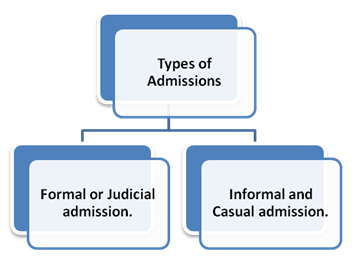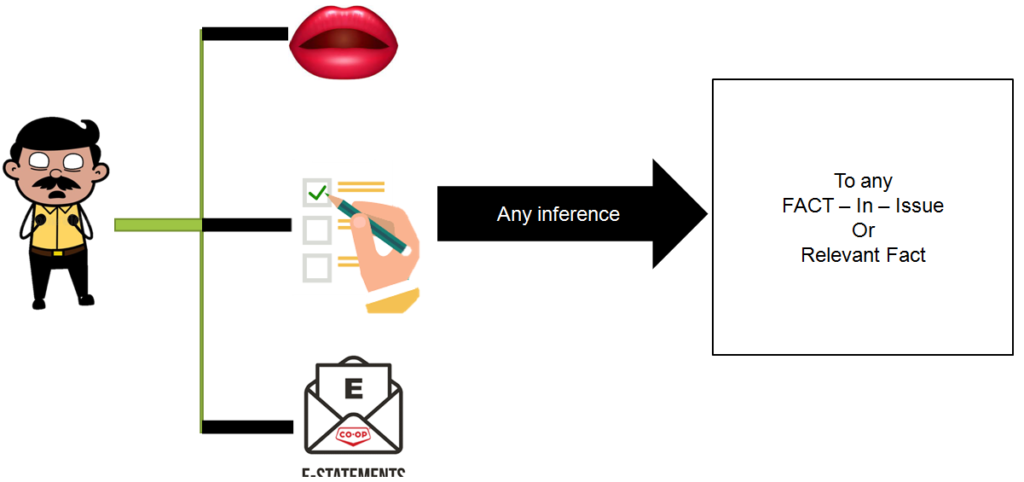Section – 17. Admission defined
- According to section 17 of Indian Evidence Act, 1872, An admission is a statement oral or documentary or contained in electronic form which suggests an inference to any fact in issue or relevant fact, which is made by any of the persons and under the circumstances, herein after mentioned.
- Section 17- 23 of Indian Evidence Act, 1872 deals with Admission
- By admission the person agrees that the fact asserted by the other party is true. Admission of fact in court helps in dispensing with the production of evidence during judicial proceedings and it saves precious judicial time.

- The definition of admission is incomplete under section – 17 as it does not mention the persons it can be made nor the circumstances under which it can be made.
- The list of persons by who, an admission can be made is found in section – 18 of the Act and the circumstances under which it can be made are mentioned in section 18 – 30.
- Thus the complete definition of the admission is like –
“ An admission is a statement suggesting an inference as to the Fact in issue or relevant fact made by the persons mentioned in section 18 and under circumstances contained in section 18 – 30.”
- The definition of admission is divided into three parts:
- It may be oral or documentary or contained in electronic form
- It must suggest inference to fact in issue or relevant fact.
- Admission will be relevant only if it is made by any person specified in the Act. (this list is to be found in Section18)
- Admission is relevant only in the circumstances mentioned in the Act. (Such circumstances are mentioned in section 18-30).
- Admission will be relevant only if it is made by any person specified in the Act. (this list is to be found in Section18)
- By the Party who is in proceeding (Sec – 18)
- By the agent who has been authorized by the party in proceeding. (Sec – 18)
- Statements made in any representative character. (Sec – 18)
- People interested in the Subject-Matter . (Sec – 18)
- Persons by whom parties derive interests. (Sec – 18)
- Admission by Persons Whose Position Must Be Proved as Against Party to Suit. (Sec – 19)
- Admissions by Persons Expressly Referred to By Party to Suit. (Sec – 20)
Admission is relevant only in the circumstances mentioned in the Act. (Such circumstances are mentioned in section 18-30).
- A party suing or being sued in a representative character making admission while holding such character.
- A person who has a proprietary or pecuniary interest in the subject matter of the suit during the continuance of such interest.
- A person from whom the parties to the suit have derived their interest in the subject matter of the suit during the continuance of such interest. (Section 18)
- A person whose position it is necessary to prove in a suit, if such statements would be relevant in a suit brought by against himself (Section 19.)
- A person to whom a party to the suit has expressly referred for information in reference to a matter in Dispute (Section 20.)

- Formal or Judicial admissions are those admissions that are made by a party during the proceedings of the case. For example- Statement given by a party to a case in front of the Magistrate during the proceedings falls under the category of Formal or Judicial admission
- Informal admissions: Informal admissions are usually made in casual conversation in ignorance of the possibility of it being used in future litigation. For example, with friends, family, neighbour, and so on.
- In case of Ajodhya Prasad Bhargava vs Bhawani Shanker Bhargava And Anr. on 8 May, 1956 the honorable court held that:
- Unlike Judicial admission which are binding upon the parties, Extra Judicial admissions are only partly binding. The exception to this principle is found in cases where they operate as or have the effect of estoppel.
Why the Admissions are Admissible
- Admission as a Waiver of Proof
-
- When parties make an admission of fact, it, in turn, amounts to a waiver of proof of such a fact. If a party admits any fact on its own then there is no need to give evidence to prove such a fact.
- Admission as statement against interest:
- Admission as evidence of contradictory statements:
- Admission is constituted as the exception of the Hearsay rule
- Admission can only be examined as whole and cannot be divided as parts.
- An admission on the point of law is not binding
- Admission by conduct is not included under this section but dealt under section – 8 of the Act . But in some circumstances , the conduct , whether active or passive becomes evidence for the admission
Evidentiary Value of Admission – A substantive piece of evidence but not conclusive proof
- In the case of of Bharat singh v. Bhagirathi (1966) , the Supreme Court held , Admission are substantive evidence by themselves , in views of section – 17 and 21 of the Indian Evidence Act , though they are not conclusive proof of the matters admitted
- Admission must be clear, specific, and unambiguous and in the own words of the person making it. An admission must be read in its entirety and no statement out of context can constitute admission of any fact.
- Admission as Estoppel
- It is under the Section 31 if the Indian Evidence Act that proves that admission may operate as estoppels as it is not just the conclusive proof of the matter. Section 115-117 of the Indian Evidence Act will apply for the admission as estoppel.
- The Supreme Court in Banarasi Das vs. Kanshi Ram, 1963said, ‘it is a weak type of evidence, and the court may reject it if the contrary is proved.’
- In Bishwanath Prasad vs. Dwarka Prasad, 1974, the Supreme Court met further observations-
- Admissions are substantive evidence by themselves though they are not the conclusive proof of the matter admitted.
- Admission duly proved are admissible in evidence irrespective of the fact whether the party making them appeared as a witness or not.
- Clarification: Admissions will be admissible even when the party is not called as a witness.









No comment